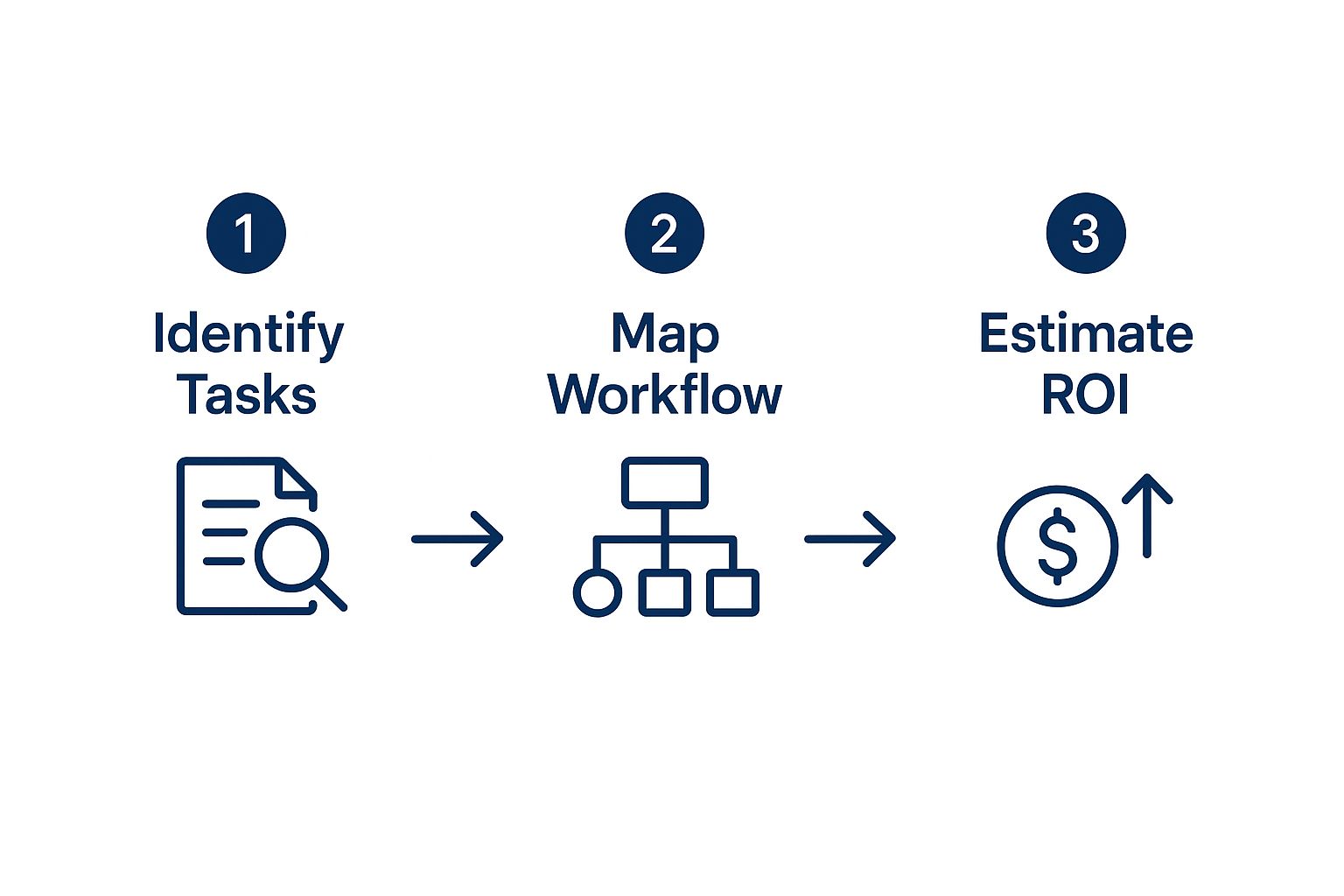Automating business processes is all about using technology to handle the repetitive, rule-based tasks that humans used to do. But let’s be clear: this isn’t just about being a little more efficient. It’s a fundamental shift necessary for survival and growth, changing how entire departments, from finance to customer service, get work done.
Why Business Process Automation Is No Longer Optional
In the fast-paced markets of the UAE and the wider region, the whole conversation around automation has changed. It’s no longer a matter of if a business should automate, but where to start and how fast to move. Those manual, time-sucking processes that were once standard are now a major handicap, slowing you down and leaving the door wide open for nimbler competitors.

The market growth tells the story. The process automation market in the Middle East and Africa (MEA) hit a value of about $6.15 billion in 2024. And it’s not slowing down, with projections showing it growing around 5.22% each year. This boom is fueled by robotics, AI, and IoT making waves across just about every major industry.
The True Cost of Inaction
Putting automation on the back burner isn’t a safe bet—it’s an expensive one. Every piece of data entered by hand, every paper form waiting for a signature, and every clunky workflow is a chance for human error. It eats up valuable employee hours and drags down your response time to customers.
When you stick with outdated processes, you’re not just missing out on efficiency. You are actively choosing to be at a disadvantage, putting customer satisfaction and your own profitability on the line.
This is exactly why getting your core systems to talk to each other is so important. For example, by integrating your sales pipeline with your financials using solid http://www.invocom.me/service/erp-and-accounting-solutions/, you create one single, reliable source of information. No more guesswork, no more painful manual reconciliation.
Shifting Focus to High-Value Work
One of the best things about automation is what it does for your people. When you automate tasks, you’re not looking to replace employees; you’re freeing them up to do more important work.
Think about it. Instead of being bogged down by mind-numbing administrative chores, your team can finally focus on what matters most:
- Strategic Planning: Digging into data to find the next big market opportunity.
- Customer Relationships: Giving customers the kind of personalized, high-quality service that turns them into raving fans.
- Innovation: Brainstorming new products or figuring out how to make your current services even better.
To really get a handle on the possibilities, it helps to understand what AI is and its business benefits. This is the technology that lets your team switch from constantly putting out fires to proactively building the future of your business.
Finding Your First High-Impact Automation Wins
Jumping into an automation project without a clear target is one of the most common mistakes I see. You get excited about the possibilities but end up spinning your wheels. Real success starts with a simple audit to find the right tasks to automate first.
Your best bets are almost always the processes your team dreads—the tedious, repetitive work that eats up valuable hours and is a breeding ground for human error. Think of it as hunting for low-hanging fruit. We’re not talking about overhauling a massive, company-wide system just yet. Instead, we’re looking for specific, rule-based activities that will give you a quick, tangible win.
This initial analysis doesn’t need to be a huge undertaking. The process of identifying, mapping, and evaluating these early projects is pretty straightforward.

As the visual guide shows, it really boils down to spotting those repetitive tasks, getting a handle on the current workflow, and then figuring out what kind of return you can expect.
Where to Look for Early Victories
From my experience, certain departments are absolute goldmines for initial automation projects. Why? Because their workflows are often naturally structured and full of repetition. If you target these areas, you can lock in an early victory that builds momentum and proves the value of automation to the rest of the company.
Here are a few classic examples I’ve seen work time and again:
-
Finance and Accounting: Manually processing invoices is the textbook case. An automated system can pull data from an invoice, match it to a purchase order, and send it off for approval without anyone ever touching a keyboard. You can literally cut processing time from days down to minutes.
-
Human Resources: Think about employee onboarding. It’s a checklist of repeatable steps: send the welcome email, create system accounts, enroll the new hire in benefits. Automating this ensures nothing gets missed and frees up your HR team to focus on making the new person feel welcome, which is what really matters.
-
Customer Service: A support ticket comes in. Instead of a person reading and routing it, an automation can scan the ticket for keywords like “billing issue” or “technical problem,” instantly categorize it, and assign it to the right person or team. This simple workflow can have a massive impact on your response times and customer happiness.
Your first project isn’t just about the tech—it’s about proving the concept. A successful pilot in one of these areas gives you a powerful case study to justify expanding automation across other departments.
Prioritizing for Maximum Impact
Okay, so you have a list of potential tasks. How do you decide where to start? Not all automation opportunities are created equal. You need to prioritize.
To help you sort through your options, it’s useful to compare high-impact processes against those that can probably wait. The goal is to identify the projects that will give you the most bang for your buck right away.
High-Impact vs Low-Impact Automation Candidates
| Process Characteristic | High-Impact Candidate (Automate First) | Low-Impact Candidate (Automate Later) |
|---|---|---|
| Frequency | High-volume, performed daily or weekly | Infrequent, done once a month or quarterly |
| Complexity | Simple, rule-based, few exceptions | Complex, requires human judgment, many variables |
| Data Format | Structured, consistent (e.g., forms, spreadsheets) | Unstructured (e.g., long-form emails, scanned PDFs) |
| Error Rate | Prone to human error, causing costly rework | Low risk of error, or errors have minor consequences |
| ROI | Clear, easily measurable (e.g., hours saved, costs cut) | Vague, difficult to quantify financial benefit |
After looking at a table like this, it becomes much clearer where your focus should be. A great starting point is any process that forces your team to copy and paste data between different applications, like moving contact info from an email into your CRM. Automating just that one task can save hours every week and eliminate the costly mistakes that come with manual data entry.
Ultimately, you want to choose a project that delivers a clear win. Get that under your belt, and you’ll have the momentum you need to tackle bigger challenges.
Choosing Your Automation Toolkit Without The Hype
The automation market is noisy. It seems like every platform out there promises to change your business overnight, and it’s easy to get lost in the marketing buzz. The real secret is to tune out the noise and zero in on what your business actually needs, not just what’s popular this week.

This diagram breaks down the typical setup for Robotic Process Automation (RPA). Seeing how the bots, controller, and development tools fit together makes it clearer how these systems handle the repetitive, rules-based tasks you want to get off your team’s plate.
Getting a Grip on the Different Kinds of Automation
“Automation” isn’t a one-size-fits-all term. It covers a whole spectrum of tech, and each type is built to solve a different kind of problem. Let’s break down the main players so you can figure out which one actually lines up with your goals.
-
Robotic Process Automation (RPA): Think of RPA as a digital employee. These “bots” are fantastic at mimicking simple human actions on a computer—clicking buttons, copying and pasting data, or filling out forms. They’re at their best with high-volume, repetitive tasks that follow a strict set of rules, like processing invoices or updating customer info in your CRM.
-
Business Process Management (BPM): BPM tools take a step back and look at the bigger picture. They’re less about automating one little task and more about orchestrating an entire workflow from start to finish, especially one that involves multiple people and different systems. A BPM platform helps you map out, run, and monitor complex processes like onboarding a new client or managing your supply chain.
-
AI-Powered Platforms: This is where things get really interesting. Adding artificial intelligence brings a layer of decision-making into the mix. AI can make sense of unstructured data (like the text in an email), spot trends, and even learn from its mistakes. It’s the right choice for work that needs a bit of judgment, like routing support tickets or analyzing customer feedback.
The business process automation market in the Middle East is absolutely booming, spreading far beyond its old industrial-only roots. In 2023, the market hit a value of around USD 0.20 billion, and it’s projected to climb by about 12.6% every year through 2033. This isn’t just a niche trend; businesses of all kinds, from finance to government, are putting these tools to work across the UAE, Saudi Arabia, and beyond.
Your Must-Have Feature Checklist
When it’s time to actually look at different tools, it’s easy to get sidetracked by flashy features you’ll never touch. You have to stay focused on the fundamentals that will make or break your success. At the very top of that list is integration.
A standalone automation tool that can’t talk to your other systems is a dead end. Real efficiency comes from a seamless flow of data between your core platforms, like your CRM and ERP.
Your new toolkit has to play nice with the software you already depend on. For example, setting up http://www.invocom.me/service/hubspot-services/custom-hubspot-integrations/ is critical for keeping sales and operations data in sync, so everyone is working from the same, up-to-date information.
Before you sign any contracts, make sure any tool you’re considering checks these boxes:
- Can it grow with you? Your automation platform should be able to handle a bigger workload as your business expands, without lagging or needing a complete overhaul.
- Is it actually easy to use? You shouldn’t need a developer on speed dial just to tweak a simple workflow. Look for platforms with intuitive, user-friendly interfaces—especially low-code or no-code options that empower your whole team.
- How well does it connect? Does it have ready-made connectors for the apps you use every day, like Shopify, Xero, or Salesforce? If not, it needs a solid, well-documented API for custom connections.
As you start shortlisting options, you might find this in-depth guide to business process automation tools useful. Making a smart choice now will save you from painful and expensive migrations down the road and put you on a path to long-term success.
A Practical Guide to Implementing Automation
Having the right tools is only half the battle. You can have the most powerful automation platform on the market, but without a smart implementation plan, it’s just expensive shelfware. The trick is to move deliberately, proving the value at each step instead of trying to boil the ocean with a massive, disruptive overhaul.
This means starting small with a manageable pilot project. Go back to the high-impact processes you identified earlier and pick one—something that’s a well-known, nagging pain point for a specific team. By narrowing your focus, you create a controlled environment to learn, adapt, and most importantly, build a powerful success story.
Secure Buy-In by Showcasing Early Wins
Your biggest challenge often isn’t the technology; it’s getting your people on board. Let’s be honest, employees can be skeptical of change, especially if they see automation as a threat to their job rather than a tool to help them. A successful pilot project is your best weapon against that resistance.
When the finance team sees invoice processing times drop by 65%, or when HR onboards a new hire flawlessly in half the time, that’s not just a statistic. That tangible success becomes your internal marketing. It shifts the conversation from abstract promises to concrete results that make everyone’s work life better.
The real goal of a pilot isn’t just to test the software. It’s to create internal champions for automation. When colleagues see the positive impact with their own eyes, they become your most persuasive advocates for expanding the project.
Before you even start the pilot, sit down with the key stakeholders and the team who will be using the new workflow. Be transparent. Clearly outline the goals, what a “win” looks like, and how this will directly benefit them day-to-day. This collaborative approach makes people feel included and invested in the outcome from the get-go.
From Pilot to Full-Scale Rollout
Once your pilot is a clear success, you’ll have the momentum and hard evidence you need to scale up. But don’t get ahead of yourself and rush this step. Use the lessons you learned from that initial test—both the good and the bad—to refine your approach for a wider rollout.
Here are a few practical steps to guide your expansion:
- Document Everything: Create straightforward documentation and training guides based on what worked in the pilot. This makes it much easier for the next teams to get up and running.
- Establish a Center of Excellence: Think about forming a small, cross-departmental team to act as the stewards of your automation strategy. They can help identify new opportunities, share best practices, and keep things consistent.
- Prioritize the Next Wave: Go back to your list of potential processes. With input from department heads, select the next one or two projects that will deliver another round of significant, visible value.
Monitor, Measure, and Continuously Improve
Finally, it’s critical to remember that automation is never a “set it and forget it” solution. Your business needs will change, software gets updated, and what was efficient yesterday might have a bottleneck today. A truly effective implementation requires ongoing monitoring and refinement.
You have to track the right key performance indicators (KPIs) to measure the real impact. These metrics should go beyond just “time saved.” Think about things like:
- Error reduction rates
- Employee satisfaction scores
- Customer response times
Regularly review these KPIs with your team. This data-driven feedback loop is what allows you to continuously tweak and improve your automated workflows, ensuring you’re getting the maximum possible value from your investment over the long term.
Seeing Automation Success in the Real World
It’s one thing to talk about automation in theory, but it’s another thing entirely to see it deliver in the real world. That’s where the abstract benefits become tangible wins. When you look at how real organizations have completely changed the way they operate, you can pull out practical lessons for your own business.

A fantastic example comes from right here in the United Arab Emirates. The UAE Ministry of Finance took on a major project to overhaul its internal workflows. This wasn’t just a small adjustment; it was a huge strategic push to improve efficiency and accuracy across the board.
Their story gives us a clear blueprint for success that can be applied to any industry, no matter the company size. It really drives home how a focused strategy, kicking off with well-defined problems, can lead to some seriously impressive results.
A Government Case Study in Efficiency
The Ministry’s approach was incredibly methodical. They started by identifying a ton of high-volume, rules-based tasks that were eating up staff time and were, frankly, magnets for human error. They then used Robotic Process Automation (RPA) to go after these specific pain points.
The results really do speak for themselves. The UAE Ministry of Finance managed to automate 63 different processes and subprocesses. This smart use of RPA led to an incredible 95% reduction in errors and cut the average time it took to handle tasks by 65%. Those numbers are a game-changer for any operation.
The Ministry’s success highlights a core principle I always tell my clients: focus on the repetitive, error-prone processes first. Fixing these bottlenecks almost always unlocks massive gains in both efficiency and quality.
This project wasn’t just about saving time. It was about improving the quality and reliability of their output, freeing up public servants to concentrate on work that requires real human insight.
Key Takeaways for Your Business
So, what can we learn from this success story? The principles are universal. It doesn’t matter if you’re a small e-commerce shop or a growing service firm, the same logic applies to your own automation journey.
A few key lessons really stand out:
- Start with a Clear Audit: The Ministry didn’t just start automating things at random. They pinpointed specific, high-volume processes where they knew the return on investment would be biggest.
- Lean on Proven Technology: They picked RPA, a mature and reliable tool that’s perfect for handling structured data and tasks that follow clear rules.
- Focus on Measurable Outcomes: They defined success with hard numbers—lower error rates and faster processing times. You should too.
This kind of transformation isn’t just for government agencies. We’ve seen similar powerful results in all sorts of industries. You can dive into more stories about how businesses have achieved incredible efficiency gains in our collection of case studies. At the end of the day, the lesson is simple: a well-planned automation project delivers clear, undeniable value.
Got Questions About Business Automation? You’re Not Alone.
Whenever I talk to business leaders about automation, the same core questions always come up. It’s completely natural to have concerns before you dive in. Getting these questions answered is the first step toward building the confidence you need to move forward.
Let’s tackle the big ones I hear all the time.
What’s This Actually Going to Cost?
There’s no single price tag for automation, and anyone who tells you otherwise isn’t being straight with you. The cost really runs the gamut. A simple workflow connecting two apps using a tool like Zapier might just be a small monthly fee. On the other end of the spectrum, a custom-built Robotic Process Automation (RPA) bot or a sophisticated AI project will naturally require a bigger initial investment.
But here’s the thing: focusing only on the cost is looking at it the wrong way. The real question is about the Return on Investment (ROI). Good automation should always pay for itself, whether through hours saved, costly errors eliminated, or a higher volume of work getting done.
My advice is always the same: start small. Pick one high-impact, low-complexity project. Prove the ROI there, and you’ll have all the justification you need to scale up.
A small, early win is the most powerful tool you have. It builds momentum and provides a concrete business case to get buy-in for bigger, more ambitious automation projects down the road.
Is This Going to Replace My Team?
This is probably the number one fear I see, and it’s almost always unfounded. For nearly every business I’ve worked with, the goal isn’t to replace people—it’s to augment them. Automation is fantastic at handling the monotonous, repetitive tasks that drain your team’s energy and creativity.
Think about all the time spent on data entry, copying and pasting information between systems, or generating the same report every week. When you hand that work over to bots, you free up your people to do what they do best—the things that require a human touch.
That means more time for:
- Big-picture strategic planning to grow the business.
- Creative problem-solving when unexpected issues pop up.
- Nurturing customer relationships and building real loyalty.
Ultimately, automation lets your team focus on higher-value work. This doesn’t just make the business more productive; it makes their jobs more interesting and fulfilling, which is a huge win for morale and retention.
What’s the Hardest Part of Automating?
It’s almost never the technology. Seriously. The biggest hurdle in nearly every automation project I’ve been a part of is change management. People are naturally resistant to new ways of working, especially if they’re worried about their jobs or don’t understand why a change is being made.
A successful rollout depends entirely on clear and honest communication. You have to bring your team into the loop from day one. Ask for their input on what processes are the most frustrating—they’re the real experts, after all. Then, provide great training so they feel confident using the new tools.
This is another reason why a small pilot project is so effective. When one team gets a clear win and starts raving about how much easier their jobs have become, that enthusiasm spreads. Before you know it, other departments will be asking when it’s their turn. That kind of organic adoption is far more powerful than any top-down mandate.
Ready to find your first high-impact automation win? The experts at Invocom can help you identify, plan, and implement solutions that deliver real results. Explore our services at https://invocom.me and start your journey towards greater efficiency.






